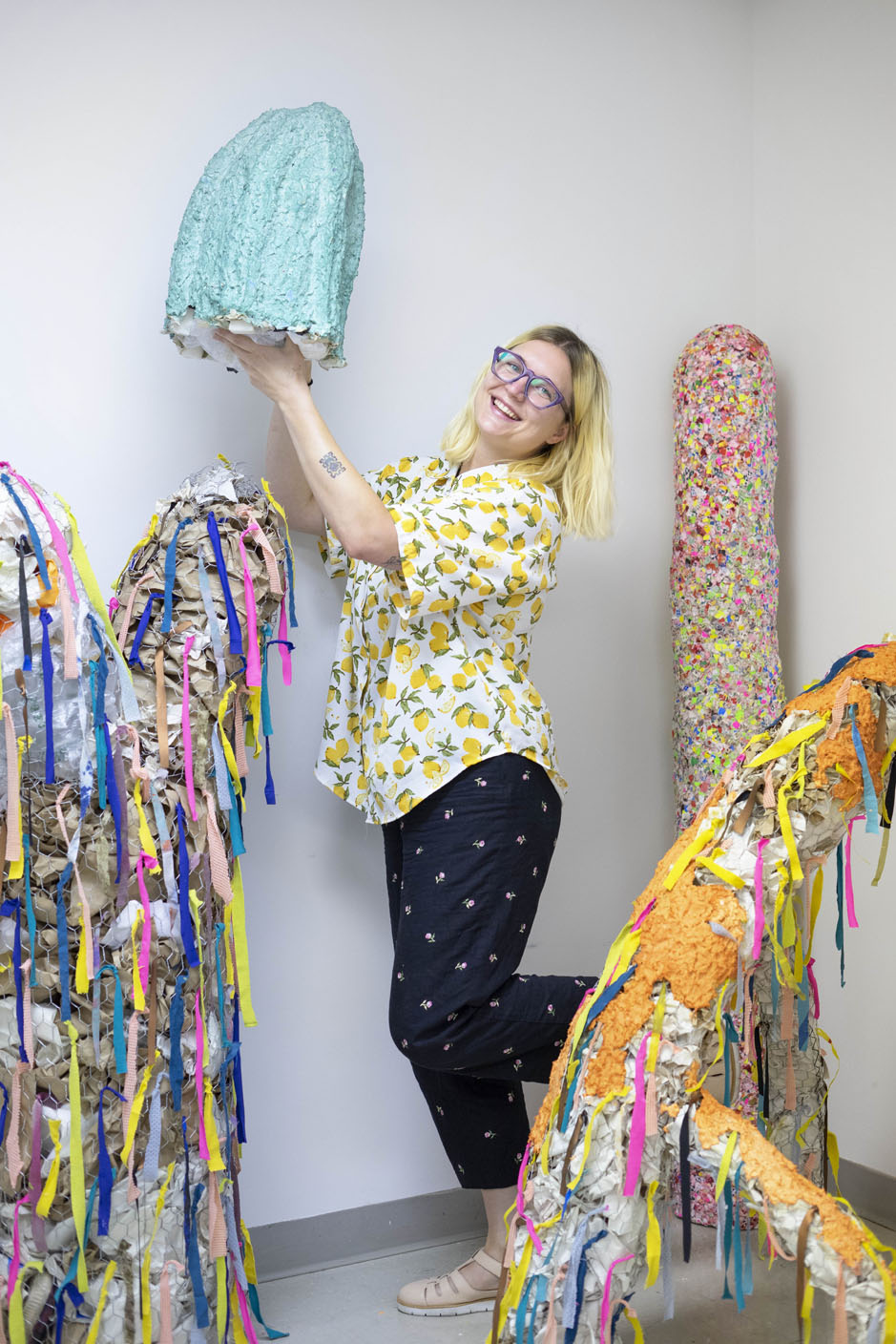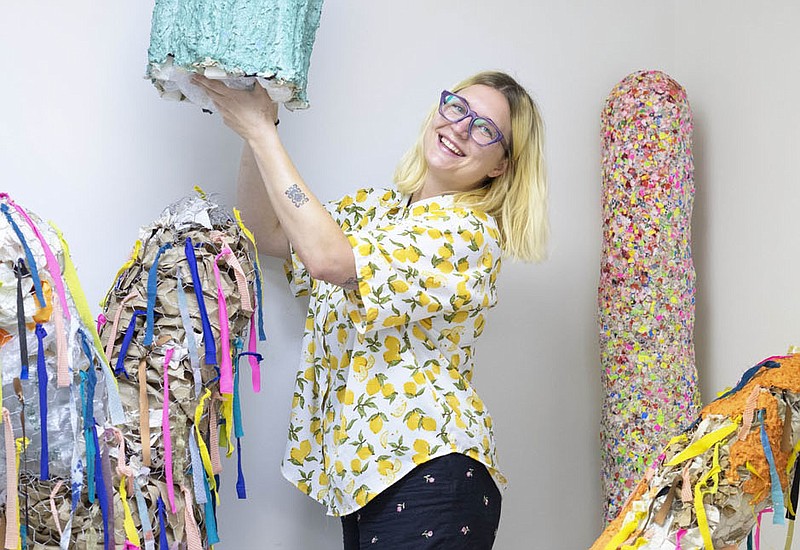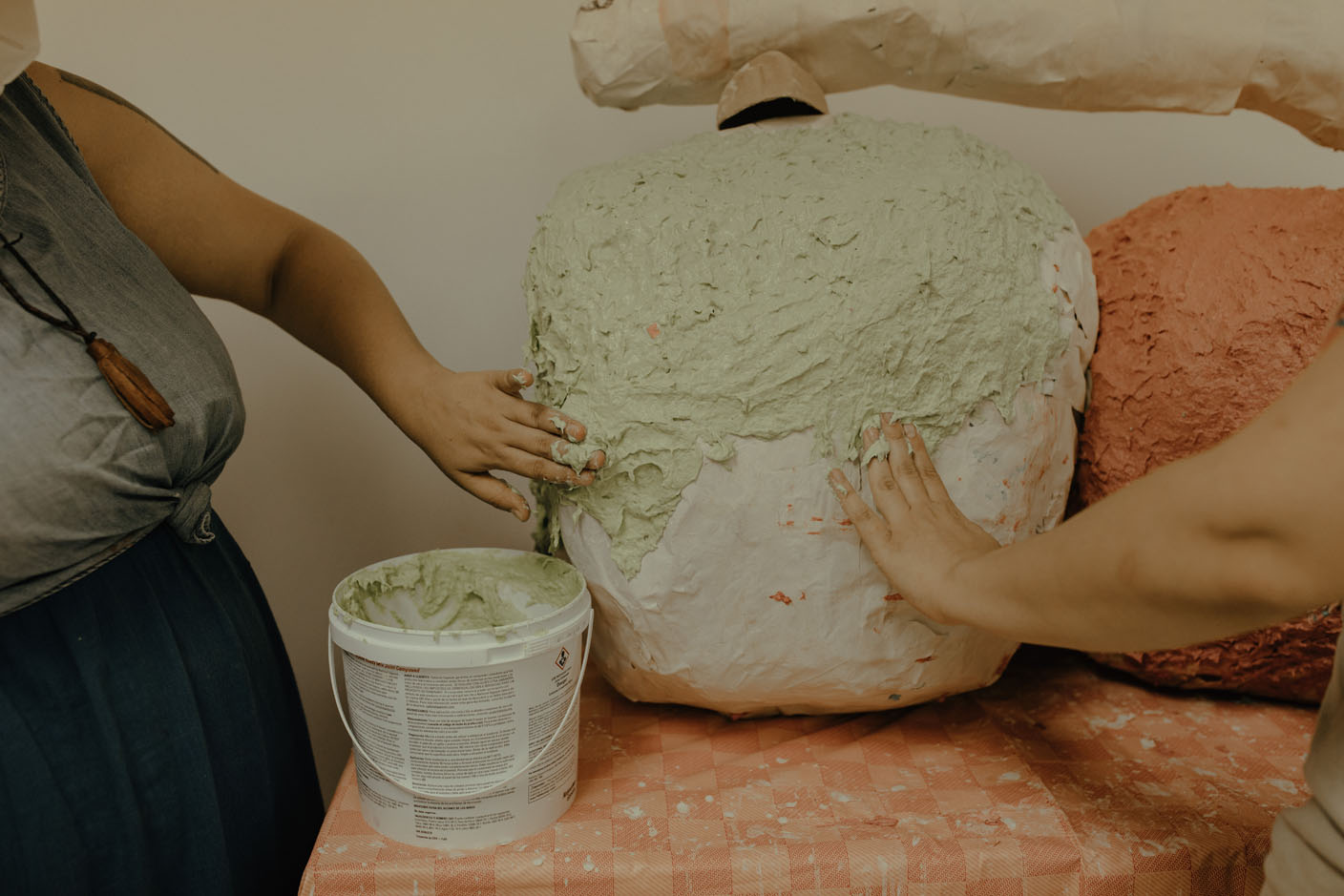If Vic Barquin's sculptures are like a goldfish in a bowl, only able to grow as big as its surroundings, its capacity to expand and morph into something entirely different positively exploded when she was accepted to the Creative Arkansas Community Hub and Exchange (CACHE) this summer.
"Now I could really see what this project could become," she says. All it needed was a little more space.
Barquin was selected as one of the 56 recipients of funding through the Tyson Family Foundation designed to activate the creative hub at 214 S. Main St. in Springdale. Her opportunity comes with a large studio for six weeks.
Now that she has the space, Barquin has six sculptures going at once, and each one can be as wide and tall as she wants or have multiple pieces. That's been a huge part of the fun, she says, to see how they could change, how they could look and just how big they could be.
Before setting up at the studio space for artists in residence at 214, Barquin had only ever made one statue. That one was created from scraps of old prints and was a part of her graduate course work at the University of Arkansas last semester.
"I liked it conceptually, I was proud of it, but there wasn't a lot of room for that to grow or for that project to explore more and different forms," Barquin says. "The school studio is small; there's not much space to explore the third dimension."
Before grad school at UA, Barquin knew she was destined for a life in the arts. She grew up in a creative family who saw craft opportunities everywhere. She recalls a walk with her mother as a child when they went past electricians working on electricity poles. The scraps they left behind were purple and green, and that day they took them home to make rings.
"That sense of reuse and creativity, innovation, has always been a part of me," she says.
Barquin attended the Massachusetts College of Art and Design which, with financial aid, was very affordable. It also had an exceptional print-making studio. Between the resources and the faculty available in print-making, Barquin made it her major and a huge part of her early career.
She moved to Chicago, where she knew she could find some built-in community among print makers and seek her footing in a print shop. Barquin worked for the Chicago Printmakers Collaborative and then got a two-bedroom apartment, using the second bedroom as a screen-printing studio.
It was one of her graduate professors at UA who alerted her and other students about CACHE offering funding for artists to do their work and make engagements and activations within the community.
"The fact that it's funded is huge," Barquin says. "As artists, we tend to be taken advantage of. A lot (of opportunities) promise exposure, but it doesn't pay the bills. We're people with financial responsibility, and it's insane to not be paid for our time."
Getting accepted to CACHE has meant a huge confidence boost after having plenty of rejections prior to it. Barquin describes it as a sort of high. On her first day at 214, they gave her and other artists a tour that ended with gift baskets.
"Right away, I felt very cared for and important," Barquin says. Being paid while working on her art means that she's been able to treat it as her summer job, but the consistency hasn't taken any fun out of it. "I've felt free to explore. Everyone at CACHE is so supportive, and you do what you need to do, so if you take a risk and try a new process, you can feel supported by the community."
That's what makes it easier for Barquin to go ahead and experiment with more sculptural work even though it's brand new to her.
Last weekend Barquin and her studio mate Junli Song hosted a collective making day so that community members could come into 214, see their process and participate. It's also a requirement of the artists-in-residence to host two events to have some interaction between the art and the community. Her second one will be in early August.
Barquin invited people to add to her sculptures, which she describes as made up of an armature of chicken wire, scrap paper and paper pulp. She mixed batches of paint ahead of time and did segments paint-by-number style so that they could apply paint to the paper pulp.
"It's nice to have people working on it," she says. "It's such a DIY process, I wanted them to get a sense that they could also do it. They can do it at home."
Barquin's art and upcoming event are just one example of the many creative offerings made through CACHE's new exchange fund program, says Amber Perrodin, artist and community manager. Felt artist Dani Ives has a workshop coming soon. Chinelos Morelenses is working on an exhibition of costumes significant for its inspirations rooted in Morelenses' heritage and culture.
Niketa Reed will be the first curator to activate an exhibit indoors at 214. Hers is called "Feed the Culture." It features food stories from various cultures and includes a documentary on the same topic. Springdale-based mural artist Toxic painted a mural for this installation. Perrodin encourages people to come see it while it lasts, since each space is temporary.
"This is the nature of the exchange fund," Perrodin says. "It's always turning over."
The CACHE Mixtape Music Series has a concert each month. Every event features a pair of groups or individual performers that are paired on genre -- the look, feel or sound has to fit together well somehow. Two have happened so far.
The first was what Perrodin describes as a glam rock band, Ozark Odyssey, whose songs were about "love, fear, discovery and tales of the Ozarks." They made costumes and had paintings on the wall for the event. They were paired with Eddie Canyon, a hip hop artist who is also engaged with the program Groundwaves.
The second concert was a combination of drone metal, throat singing and cinematic sound design with an artist who mixes his own music and plays cello. Their shared vision was focus on the experience it would create, so they used a fog machine and creative lighting to add effects. It took time, getting together early, rehearsing and listening to each others' sounds.
"It's a fun sort of trial and experiment," Perrodin says. "I was blown away with how they pulled it together. (In the first concert) Eddie Canyon opened with the first set and then he played drums with Ozark Odyssey. It was a surprise for the audience to see how they intersected and took some collaboration."
That's exactly what CACHE organizers hoped would happen organically, that collaboration would unfold between the artists and musical groups, and Perrodin says they are already seeing that.
"It's interesting to see how they're all hanging out and building community," she says. "We weren't quite sure how it was going to go, but that's how we would have wanted it."
Go & Do
Engage With Vic Barquin’s Art
When: 5-8 p.m. Aug. 4
Where: 214 S. Main St. in Springdale
Cost: Free
Information: Find more CACHE events at cachecreate.org/cxf/#events
 Vic Barquin is an experienced print-maker who is getting to explore the process of making sculptures this summer while she spends six weeks as an artist-in-residence. The CACHE Exchange provides artists with funding, studio space, opportunities for community interaction and guidance with the technical parts of turning art into a business. (Courtesy photo/Sky Maggiore)
Vic Barquin is an experienced print-maker who is getting to explore the process of making sculptures this summer while she spends six weeks as an artist-in-residence. The CACHE Exchange provides artists with funding, studio space, opportunities for community interaction and guidance with the technical parts of turning art into a business. (Courtesy photo/Sky Maggiore)

